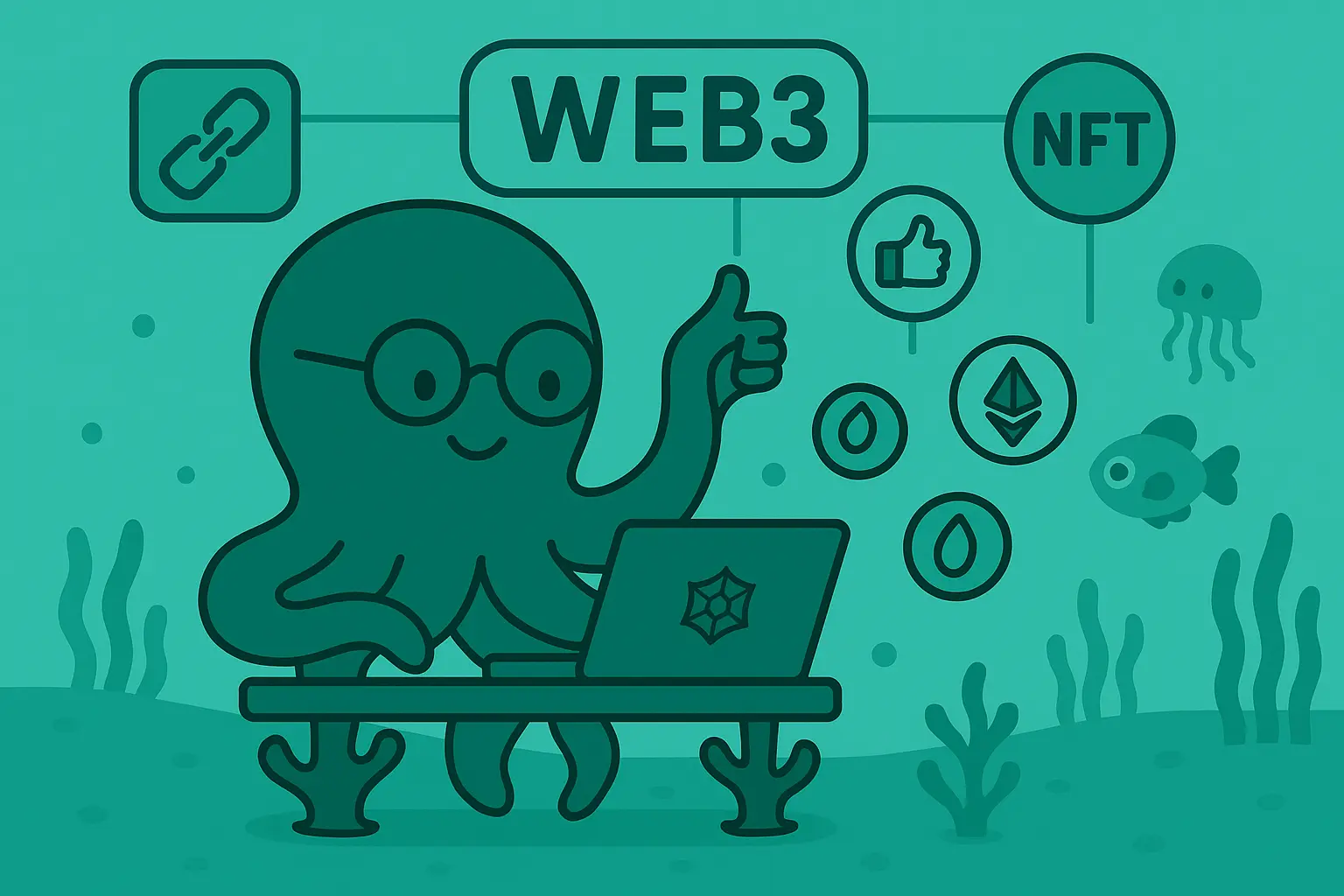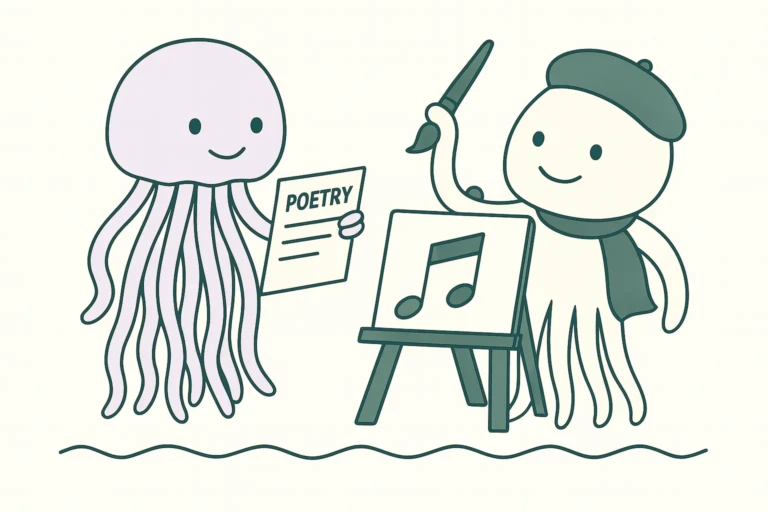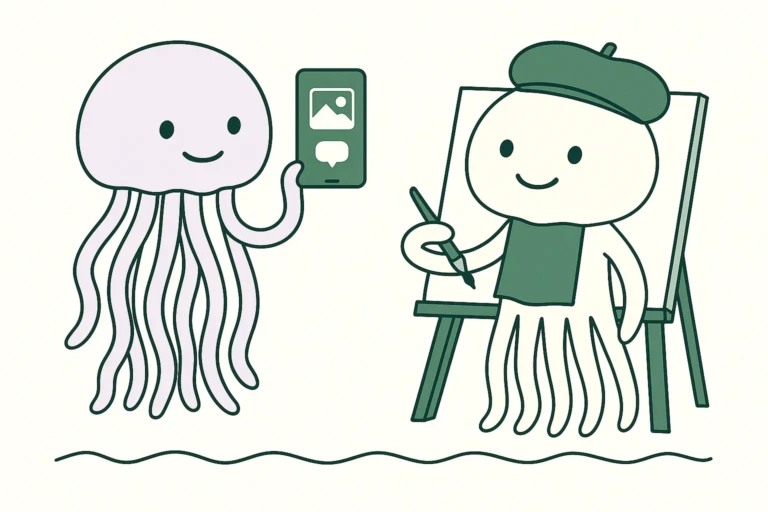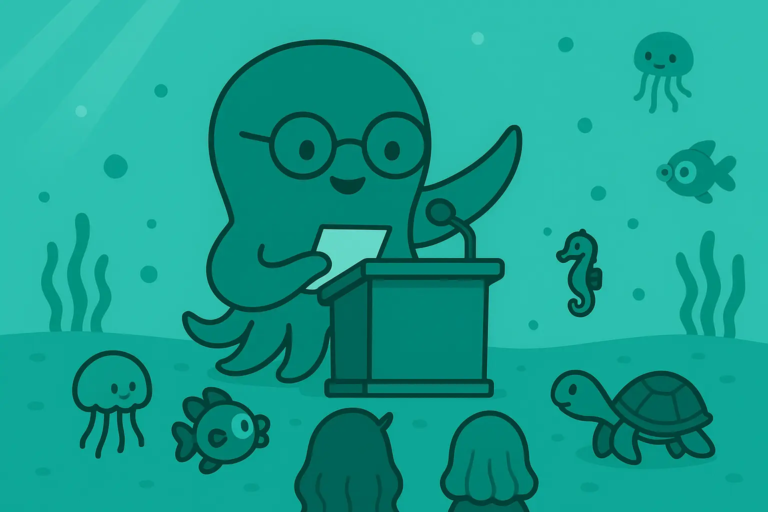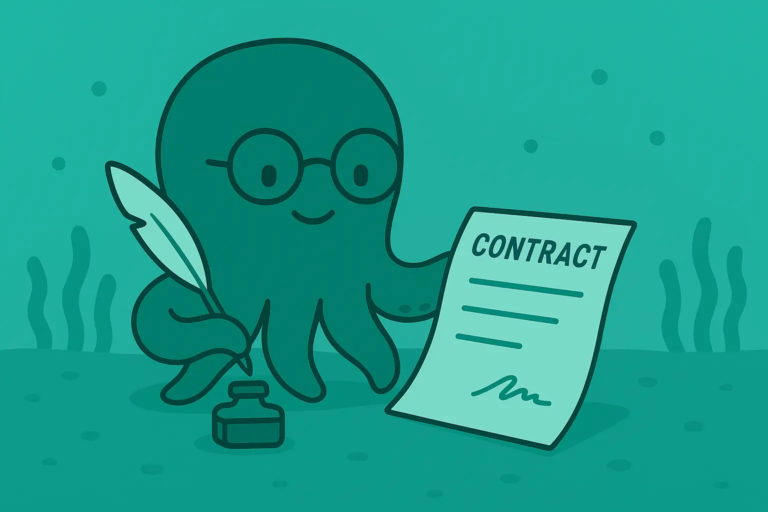10 ChatGPT Prompts For Web3 Developers
Web3 is fast, complex, and constantly evolving.
Writing smart code isn’t the only challenge — it’s also about explaining, debugging, documenting, and shipping with clarity.
These ChatGPT prompts help Web3 developers move faster.
Whether you’re building smart contracts, docs, landing pages, or technical threads, this list gives you quick support when you need it most.
10 ChatGPT Prompts For Web3 Developers
1. Prompts to Explain a Smart Contract Function
#CONTEXT:
You’ve written or reviewed a smart contract function — now you need to explain it clearly.
#GOAL:
Break down the function’s purpose, flow, and security in simple terms.
#RESPONSE GUIDELINES:
• Code: [insert function code]
• Chain: [insert: Ethereum, Polygon, etc.]
• Audience: [insert: devs, non-devs, docs, audit prep]
• Use short, clear explanations
• Highlight potential risks or edge cases
#OUTPUT:
A clean explanation of what this function does and why it matters.2. Prompts to Write Smart Contract Docs
#CONTEXT:
You want to document your smart contract so other devs or auditors can follow it.
#GOAL:
Generate contract documentation with clarity and structure.
#RESPONSE GUIDELINES:
• Contract summary: [insert]
• List functions and purposes
• Include inputs, outputs, modifiers, and visibility
• Optional: add inline examples
• Keep formatting clean and copy-paste ready
#OUTPUT:
Technical docs for a smart contract or dev portal.ChatGPT Response:

3. Prompts to Generate a Solidity Function From a Description
#CONTEXT:
You know what the function should do — but want to see how it would look in Solidity before you write it from scratch.
#GOAL:
Write a secure, gas-efficient Solidity function based on my input.
#RESPONSE GUIDELINES:
• Describe the logic: [insert what it should do]
• Solidity version: [insert pragma]
• Include error handling, access control, and gas optimization
• Optional: make it ERC-compliant if needed
• Add comments for readability
#OUTPUT:
A functional Solidity snippet I can test or expand on.4. Prompts to Review Smart Contract Code
#CONTEXT:
You’ve written contract code — now you want help spotting mistakes or inefficiencies.
#GOAL:
Get a review of logic, readability, and best practices.
#RESPONSE GUIDELINES:
• Code: [insert Solidity or Vyper code]
• Focus: [insert: gas cost, security, logic flow]
• Highlight risky or unnecessary patterns
• Suggest edits or refactors
• Use clean formatting and short comments
#OUTPUT:
Feedback I can use to tighten the contract before deploying.ChatGPT Response:
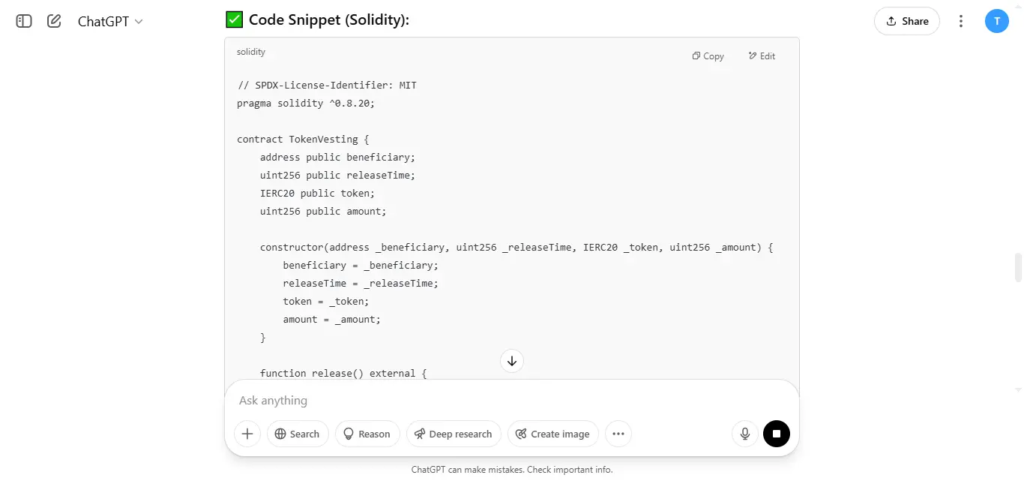
5. Prompts to Generate NFT Metadata Quickly
#CONTEXT:
You’re deploying NFTs and need metadata in the right format — fast.
#GOAL:
Generate compliant NFT metadata for a given item.
#RESPONSE GUIDELINES:
• Name: [insert NFT name]
• Description: [insert]
• Traits: [insert attributes list]
• Include standard fields (name, description, image, attributes)
• Format as a clean JSON file
#OUTPUT:
Metadata ready for upload to IPFS or direct mint.6. Prompts to Explain Gas Fees to Non-Technical Users
#CONTEXT:
You’re writing FAQs, help docs, or tweets — and need to explain gas fees simply.
#GOAL:
Make gas fees understandable without diving into protocol-level mechanics.
#RESPONSE GUIDELINES:
• Audience: [insert type: new users, community, investors]
• Topic: [basic gas fees, L2 savings, how to reduce cost, etc.]
• Use analogies or real-life examples
• Keep it under [insert word count]
• Optional: include a visual or line for tweets
#OUTPUT:
A simple breakdown of what gas fees are and how they work.ChatGPT Response:
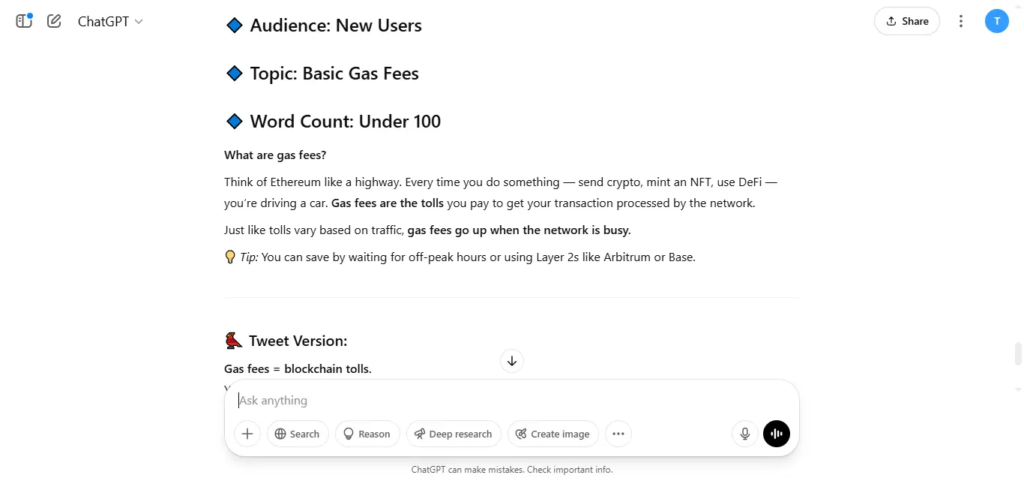
7. Prompts to Create a Web3 Landing Page
#CONTEXT:
You’re launching a Web3 app and need a landing page that’s clear and not full of buzzwords.
#GOAL:
Write copy that explains the value, builds trust, and drives action.
#RESPONSE GUIDELINES:
• Project name: [insert]
• What it does: [insert in one line]
• Target user: [insert audience]
• Tone: [insert tone: clean, bold, builder, friendly]
• Include headline, 3 bullets, and CTA
#OUTPUT:
Landing page copy I can paste into my site or Notion.8. Prompts to Turn a GitHub ReadMe Into Human English
#CONTEXT:
Your GitHub README is technical — but you want a clean, simple version for onboarding or investors.
#GOAL:
Simplify a README for non-technical readers.
#RESPONSE GUIDELINES:
• Paste the README
• Target reader: [insert: potential contributor, investor, community]
• Keep tech terms, but explain them simply
• Add bullet-point features, one-line install, and use cases
• Optional: include visuals or links
#OUTPUT:
A clean “explain like I’m 20” version of my GitHub project.ChatGPT Response:
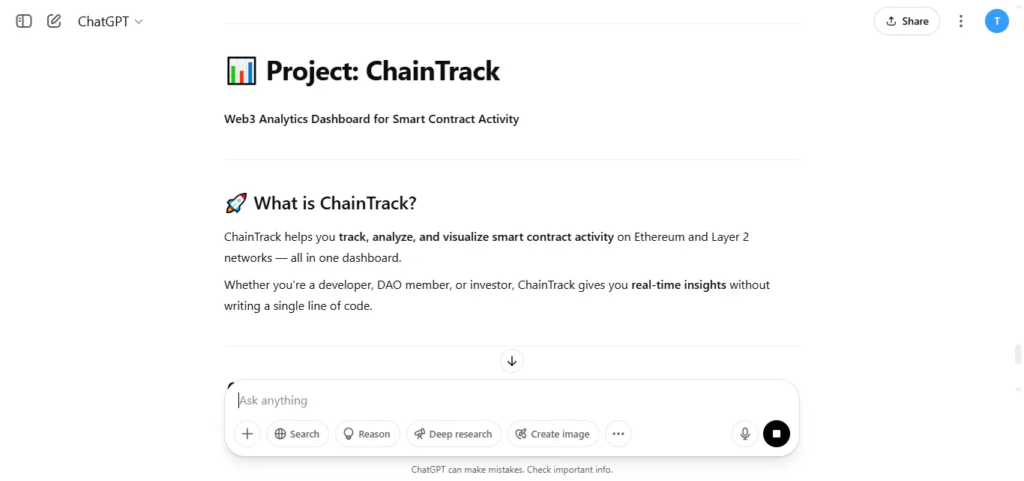
9. Prompts to Draft a Governance Proposal
#CONTEXT:
You’re submitting a proposal for a DAO — and want it clear, actionable, and credible.
#GOAL:
Create a structured proposal that follows governance best practices.
#RESPONSE GUIDELINES:
• Proposal title: [insert]
• What it solves or changes: [insert summary]
• Include sections: background, proposal, motivation, impact
• Tone: formal, concise
• Optional: add voting options or timeline
#OUTPUT:
A governance proposal ready for Snapshot or forum discussion.10. Prompts to Create a Web3 Developer Learning Plan
#CONTEXT:
You’re learning Web3 dev — and want a plan to get good, fast.
#GOAL:
Build a focused roadmap with skills, tools, and projects.
#RESPONSE GUIDELINES:
• Current level: [insert beginner/intermediate/advanced]
• Time available: [insert hours per week]
• Goal: [insert goal: smart contracts, frontend, full-stack]
• Suggest tutorials, projects, and tools by week or stage
• Keep it realistic
#OUTPUT:
A custom learning path to become a Web3 dev.How to Use These Prompts Effectively
• Start with a real use case
Whether you’re building, writing, or explaining — feed ChatGPT the actual code or content.
• Ask for follow-ups
Say “make it cleaner,” “add security notes,” or “rewrite for non-devs” — it’ll adjust.
• Mix prompts
Write the code, then document it. Build the feature, then write the landing page.
• Save the gold
Turn your best prompts into personal tools you can reuse across builds.
• Don’t use it blindly
Always double-check outputs — especially when dealing with smart contract logic or security.
Conclusion:
Web3 dev is already hard. Writing, explaining, and packaging your work shouldn’t be.
These ChatGPT prompts help you build faster, explain better, and ship smoother.
Use them in your workflow — and let AI handle the extra noise while you focus on shipping.

